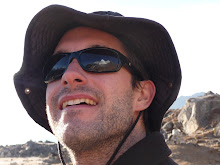I have been deeply immersed over the past three weeks in my work as a Volunteer Strategy Consultant with VisionSpring. This weekend is the third weekend in a row that I am in Santa Ana working with local representatives of VisionSpring in their headquarters and in the field. It has been a terrific experience thus far, and I have been incredibly impressed by the commitment and quality of the field staff. The last three weeks have been a whirlwind of a learning experience, and as I continue to deepen my knowledge about VisionSpring and the local environment, I have started to dig into my project.
Country Director Heidy, her daugher Esmeralda, and me
But first a bit more about VisionSpring, a non-profit organization whose mission is “to reduce poverty and generate opportunity in the developing world through the sale of affordable eyeglasses”. While working on medical missions, VisionSpring’s founder, practicing optometrist Dr. Jordan Kassalow, became aware of how difficult it is for low-income people in the developing world to access affordable corrective eyewear. He regularly encountered people who if they could only see better could be happier and more productive for years longer. VisionSpring has estimated that an “investment in one pair of glasses can generate a greater than 27X return to the wearer”.
Thus, Dr. Kassalow co-launched VisionSpring in 2001 under the name Scojo Foundation with Scott Berrie. The model they developed is to sell low-cost “ready-made reader” glasses for people suffering from presbyopia, an age-related condition where people find it progressively harder to focus on close-range objects. This condition affects the majority of adults over the age of 40, so the need across the world is substantial. In fact, many of you reading this probably know exactly what I am talking about because you wear glasses for just this condition. Whether you are sewing, reading, or using a computer, presbyopia can make otherwise simple tasks extremely difficult. When one’s livelihood depends on being able to see clearly, such as for a seamstress, the ability to perform those simple tasks can be critical.
The glasses are sold through two principle channels: the first is through franchise partners who deploy the VisionSpring model through their own networks; the second is through a direct Vision Entrepreneur channel, which I will describe in more detail below because it is the model used in El Salvador.
The idea quickly took off both in terms of growth and accolades.
Today VisionSpring is serving India, Bangladesh, Guatemala, El Salvador, Ghana, Ethopia, Kenya, Nigeria, and Zambia, with pilot programs and/or designs for a slew of other countries. Among a long list of awards, VisionSpring recently won the 2009 Skoll Award for Social Entrepreneurship, one the most prestigious awards in social entrepreneurship.
Here’s a cool article that was in Ode Magazine back in March.
Despite the impressive results, one thing I really appreciate about the organization is how humble and honest the headquarters staff is about their business model and its limitations, which I think makes them more likely to learn from challenges, and overall makes them a better investment. This is probably an important reason why VisionSpring has been able to raise a sizable equity fund to continue to grow the business.





No comments:
Post a Comment